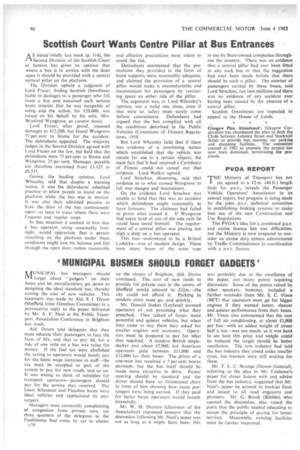Scottish Court Wants Centre Pillar at Bus Entrances
Page 48

If you've noticed an error in this article please click here to report it so we can fix it.
AS stated briefly last week (p. 114), the Second Division of the Scottish Court of Session has given its opinion that where a bus is in service with the door open it should be provided with a central vertical pillar on the platform.
The Division upheld a judgment of Lord Fraser, finding Scottish Omnibuses liable in damages to a passenger who fell from a bus and sustained such serious brain injuries that he was incapable of suing and the action, for £20,000, was raised on his behalf by his wife, Mrs. Winifred Wyngrove. as curafor bonis.
Lord Fraser, after proof, assessed damages at £12,500, but found Wyngrove 75 per cent to blame for the accident. The defendants appealed. The majority judges in the Second Division agreed with Lord Fraser on the law, but held that the defendants were 75 per cent to blame and Wyngrove 25 per cent. Damages payable are therefore increased from £3.125 to £9,375.
Giving the leading opinion, Lord Wheatley said that despite a warning notice, it was the defendants' admitted practice to allow people to stand on the platform while the bus was in motion. It was also their admitted practice to have the door of the bus continuously open—at least in areas where there were frequent and regular stops.
In that situation it seemed to him that a bus operator, using reasonable foresight, would appreciate that a person travelling on the platform under these conditions might lose his balance and fall through the open door, unless reasonable and effective precautions were taken to avoid the risk.
Defendants maintained that the precautions they provided in the form of hand supports were reasonably adequate, and claimed the provision of a central pillar would make it uncomfortable and inconvenient for passengers by restricting space on either side of the pillar.
The argument was, in Lord Wheatley's opinion, not a valid one since, even if that were so, safety must surely come before convenience. Defendants had argued that the bus complied with all the conditions described in the Public Vehicles (Conditions of Fitness) Regulations, 1958.
But Lord Wheatley held that if there was evidence of a convincing nature which established that the vehicle was unsafe for use in a certain re7spect, the mere fact that' it had received a Certificate of Fitness could not cancel out that evidence. Lord Walker agreed.
Lord Strachan, dissenting, said that evidence as to what caused Wyngrove to fall was meagre and inconsistent.
On the evidence Lord Strachan was unable to hold that this was an accident which defendants ought reasonably to have foreseen. The claimant had failed to prove what caused it. If Wyngrove had taken hold of one of the side rails he could have saved himcelf. The requirement of a central pillar was placing too high a duty on a bus operator.
This bus—understood to be a Bristol Lodekka—was of modem design. There were many buses of the same type in use by State-owned companies throughout the country. There was no evidence that a central pillar had ever been fitted to any such bus or that the suggestion had ever been made before that there should be such a pillar. The number of passengers carried by these buses, said Lord Strachan, ran into millions and there was no evidence of any accident ever having been caused by the absence of a central pillar.
Scottish Omnibuses are expected to appeal to the House of Lords.
PVOA REPORT
THE Ministry of Transport has not yet agreed to a 12 m. (40 ft.) length limit for p.s.v., reveals the Passenger Vehicle Operators'. Association in its annual report, but progress is being made by the joint p.s.v. technical committee in establishing braking systems to make best use of the new Construction and Use Regulations.
The PV0A's idea for a combined p.s.v. and excise licence has met difficulties, but the Ministry is now prepared to consider an excise duty system administered by Traffic Commissioners in combination with a p.s.v. licence.
























































































































